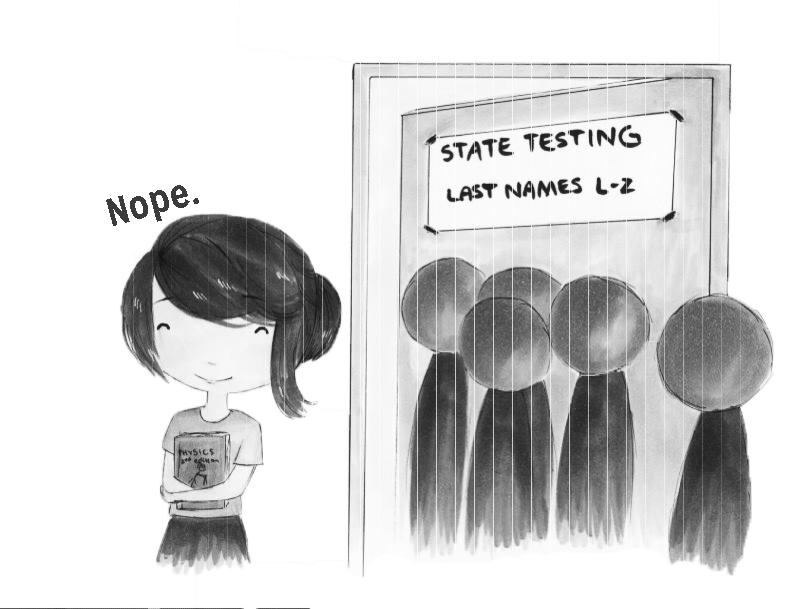
Near the end of the previous school year, as students in K-12 schools all over the nation sat down for state standardized testing, some parents refused to let their children participate. In New York, 20 percent of eligible students, 200,000 altogether, opted out, compared to 50,000 the previous year. This movement was the result of increasing resistance from a coalition of parents and teachers, united under the stated goal of placing greater emphasis on teaching rather than standardized testing; however, there were ranges in motivations for the resistance.
While the opt-out movement began with the “No Child Left Behind” legislation passed in 2001, participation rates mostly stayed above 95 percent. The 2014 school year marked New York’s third year under the new Common Core standards, which have relatively higher standards that make passing more difficult. The increasing weight of standardized testing on teacher and school evaluations mobilized the teachers’ union, advocating that student performance is based on other factors that teachers have minimal control over.
The unexpectedly high opt out percentage in New York raised an important question over Title 1 federal funding, a grant that gives money to relatively poor schools for programs, provided that said schools meet certain conditions — one of those being a minimum of 95 percent student participation in standardized testing. Opponents believe that punishing the poorest of the schools because a minority of families refuse to participate logically does not make sense; however, others cite limited participation as an impediment to improving schools. This allows the federal government to ensure that funding is not being misused.
What differentiates heated responses against New York’s standardized testing from the relative calm in California is the implementation of the test. To accelerate the implementation of Common Core standards in statewide standardized tests, New York enlisted the education company Pearson to create a test with higher standards and immediately used the results to judge teachers and schools. The low pass rate of 30.4 percent of elementary school students passing the reading test stimulated an outcry against the test, as improperly calibrated and harsh. Additional anecdotes of children frustrated with seemingly ridiculous Common Core problems added heat to the issues. In contrast, California’s implementation of the computer-based Smarter Balanced Test has been steadier than New York as the results have not yet been used to measure “success” and have been unopposed by the teacher union.
Proper calibration will take time, however. As the Smarter Balanced test remains in its infancy, Ann Phillips, Aragon’s Data Analyst, says, “Aragon’s test results from last year under the new tests might not be officially used for anything…[for] the purpose of the new tests is to gauge improvement over time, and this year is most beneficial as a baseline.”
Restructuring schools for improvements remains the end goal. According to the Government Accountability Office, from 2002, when “No Child Left Behind” was passed, to 2008, only 5 percent of schools that failed tests multiple years in a row or failed to graduate two thirds of their class were taken over by the state; only 2.5 percent were closed; and the most popular option was establishing internal groups focused on learning or altering the range of grades given. The effectiveness of these alterations has varied case to case, but proponents of testing argue that it diagnoses problems without the draconian consequences testing critics sometimes cite in opposition.
Yet people resist and opt out based on the belief that standardized testing cannot fully represent intellectual development or determine the individual needs of students. Many fear that the new tests and standards might limit what is taught. For instance, when the new math standards came out, its “decelerated” math track riled up many parents. Linda Siguenza, an art and history teacher, parent, and active community member, says, “At a meeting [at Highlands Elementary School] explaining the Common Core standards for parents with students about to go into middle school, this father of a second grader stood up and said how these standards are fine for those who want to go into [public middle] schools, but are not good enough for his daughter.”
Time, however, has quelled the initial uproar, at least for now. Siguenza says, “This group was only very volatile initially and what started as a grassroots movement gradually became less hostile.”
Not everyone who decides to opt out does so for pure ideology. For instance, according to an EdSource article, certain parents at Gunn High School located in Palo Alto reportedly allowed their child to opt out so they would have more time to study. Other parents cited standardized testing as an unneeded stress.
There is yet another group in the opt out movement that includes those concerned with its fairness towards those in special education programs and English learners, as the educational priorities of these individuals differ drastically from children. This disparity has served as a source of frustration for some and a flawed means of evaluating student and teacher competency. This same principle applies to those of a lower socio-economic class, as factors out of their control may limit their ability to do well and seemingly skew results.
The opt out movement loosely holds together different groups under common purpose for now, but there is no clear solution. Time will test the future of this movement.




